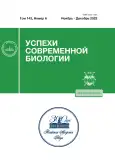Wolf (Canis lupus L.): Territory or Habitat
- Authors: Kochetkov V.V.1
-
Affiliations:
- Central Forest State Natural Biosphere Reserve
- Issue: Vol 143, No 6 (2023)
- Pages: 595-602
- Section: Articles
- Submitted: 24.12.2023
- Published: 01.11.2023
- URL: https://journals.rcsi.science/0042-1324/article/view/229433
- DOI: https://doi.org/10.31857/S0042132423060066
- EDN: https://elibrary.ru/QJIQFD
- ID: 229433
Cite item
Full Text
Abstract
The organization of the living space of animal populations is diverse, but in the generalized variant it is characterized by two concepts – “territory” and “habitat area”. The first provides for the protection of the “territory” by single individuals, married couples, families, flocks using acoustic signals and olfactory labels to mark boundaries. The second does not provide for such strict habitat protection. It is generally recognized that wolf families are characterized by lifestyle according to the “territory” type. But long-term studies of the ecology and behavior of wolf families (1975–2022) in the Central Forest Biosphere Reserve do not confirm this opinion: reasoned doubts about the “territoriality” of wolves are presented. The nature of the change in the size of the “territories”, the features of the placement of labels, the absence of conflict situations suggest the organization of living space according to the type of “habitat”.
About the authors
V. V. Kochetkov
Central Forest State Natural Biosphere Reserve
Author for correspondence.
Email: kvaldai@mail.ru
Russia, Tver region, village Reserve
References
- Кочетков В.В. Динамика и структура популяций волка в фазе роста численности при антропогенном прессе: особенности и закономерности // Изв. РАН. Сер. биол. 2007. № 2. С. 229–238. [Kochetkov V.V. Dynamics and structure of developing wolf population under anthropogenic pressure: features and patterns // Biol. Bull. 2007. V. 34. P. 185–193.]
- Одум Ю. Экология. Т. 2. М.: Мир, 1986. 376 с.
- Панов Е.Н. Поведение животных и этологическая структура популяций. М.: Наука, 1983. 427 с.
- Ballard W.B., Whitman J.S., Gardner C.L. Ecology of an exploited wolf population in south-central Alaska // Wildlife monographs. 1987. № 98. 54 p.
- Fuller T.K. Population dynamics of wolves in north-central Minnesota // Wildlife monographs. 1989. № 105. 41 p.
- Jenkins D. Social behaviour in the partridge Perdix perdix // Ibis. 1961. V. 103a. P. 155–186.
- Mech D., Adams L., Meier T. et al. The wolves of Denali. Minneapolis: Univ. Minnesota Press, 1998. 227 p.
- Vucetich J.A., Peterson R.O. Ecological studies of wolves on Isle Royale. Annual report 2012–2013. www. isleroyalewolf.org
Supplementary files



















